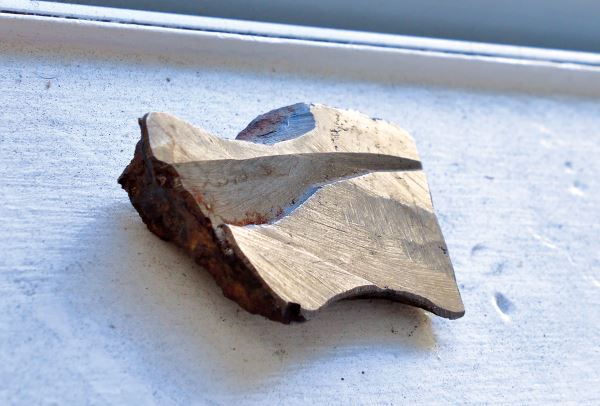
Former Idaho Falls resident Russell Thomas was just as surprised as everyone else when he found a meteorite on Mount Saint Mary’s University (MSMU) campus in Los Angeles. The discovery felt more than coincidental to Thomas who has a passion for astronomy and even wrote that he wanted to find a meteorite on his bucket list before moving to Los Angeles. “When I saw it, I thought, ‘This is too weird,’” said Thomas.
Russell Thomas’s interest in all things space began in his childhood when he lived in rural Idaho. “I grew up in the country and I remember I would sleep on the trampoline in the summertime,” said Thomas. “I’d stay up half the night staring at the stars. Then I got a telescope when I was 12. I’ve loved looking at the stars ever since I was little.”
 The Discovery
The Discovery
In the late 1800s a mining prospector, Edward Doheny, moved to California. His fortune, which came from the oil wells he built across the state, bought him a 55-room mansion that was later willed to the Catholic Church after his murder. The church later turned the mansion over to MSMU and it became a part of the campus. It is by the campus’ backyard pool that Russell Thomas first made the discovery of the meteorite.
“I didn’t tell anyone about it for a few months because I enjoyed just spending time with it, looking at it,” said Thomas. “I went to school at night so I would stop and say hello. I know all the details and grooves of it, so when I see it in the museum now it’s like, ‘Oh, that’s my buddy.’”
The museum housing the meteorite—aptly named the Doheny meteorite after the oil baron who previously owned it—is a part of the University of California, Los Angeles (UCLA). The meteorite museum on UCLA’s campus is the perfect home for the Doheny meteorite as it is the largest meteorite museum in the United States’ west coast, and UCLA’s own professor and meteorite specialist John Wasson was the one to confirm the legitimacy of the meteorite.
The Examination
Testing and eventually moving the meteorite was quite the task. A meteorite’s size can be quite deceiving as the composition adds weight a normal rock wouldn’t have, therefore making the average meteorite about three times as heavy as a normal rock. With the Doheny meteorite weighing in at about 350 pounds, moving the whole rock for testing wasn’t an option.
A sample of the meteorite about the same size as a slice of bread was cut and taken to a lab for Professor John Wasson to examine and test. Wasson was initially reluctant to take up the task as his expertise has brought many false inquiries to his door about potential meteorites; however, he knew with certainty upon seeing the Doheny meteorite in person that it was legitimate.
Similarly, Russell Thomas was able to identify the meteorite upon sight because his interest in astronomy drew him to learn about the differences between natural rocks and meteorites. “It didn’t look like any rock that you see ordinarily,” he said, “it’s just melted silica; it has like a rusty, almost shiny surface to it because it’s melted. Then it has the weirdest shape and signature thumbprints all over it where, when it entered through the atmosphere, the metal got so hot that it actually started to melt holes in the meteorite. You can actually see the grooves where it started to melt thumbprints into the meteorite as it went through the atmosphere of the earth.”
The Journey
Just as Russel Thomas has lived in multiple states, so too has the Doheny meteorite. The hunk of space rock originates from Canyon Diablo in Arizona at the site of a crater. Approximately 50,000 years ago, an iron meteor crashed into the earth near Flagstaff, Ariz. Many meteorites have been mined from the resulting crater which measures 600 feet deep and three-quarters of a mile wide. How or why Edward Doheny transported his hefty prize from the Arizona crater to his poolside in California is still unknown, although current theories center around his travels in the southwestern part of the United States.
Russell Thomas’s multistate story may focus much on southern California; however, it is community members like him that add to the cultivated history and culture of Idaho Falls. The state of Idaho still remains one of the best places to observe activity in space, such as meteor showers, because of remote rural towns and the lack of light pollution that negatively affects much of populated America. With greater access to the beauties and wonders of nature, Idaho becomes a source of inspiration and passion for dreamers like Russell Thomas. When we look at the accomplishments of past and current residents of Idaho Falls, it’s clear that their roots here are just the beginnings of great stories of the future.